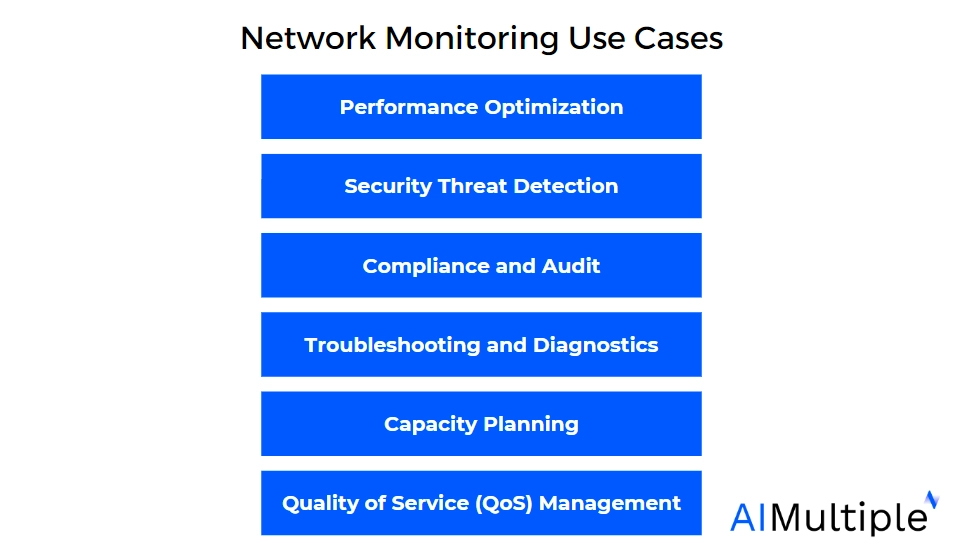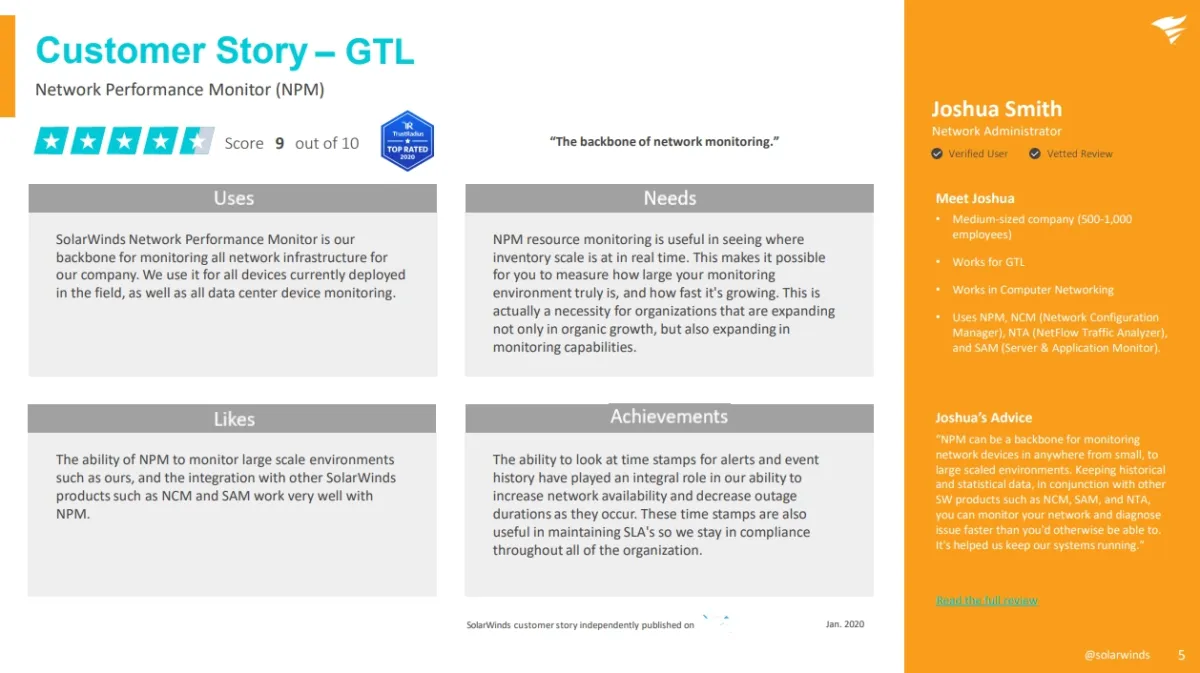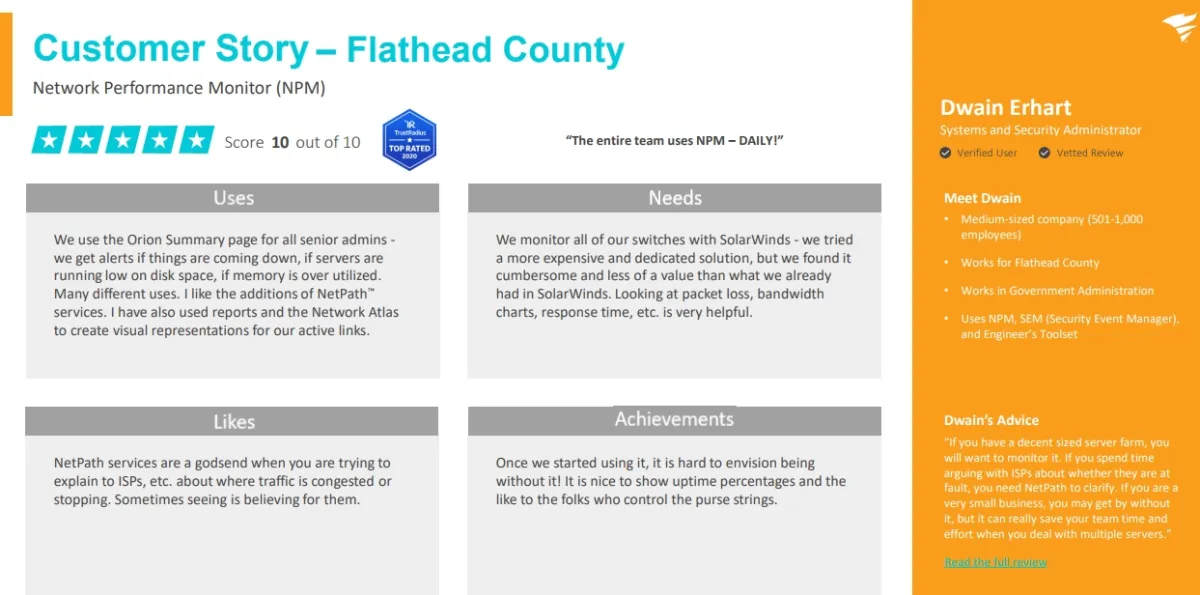Effective network monitoring is a cornerstone of efficient IT management, especially for complex, hybrid cloud environments. Through real-world examples, we will illustrate the practical benefits and applications of network monitoring:

Core Network Monitoring Use Cases
1. Performance Optimization
Performance is crucial for identifying bottlenecks and inefficiencies in network monitoring use cases. Organizations can make informed decisions about network upgrades and configuration changes by analyzing traffic patterns and bandwidth utilization, ensuring optimal performance, and avoiding unnecessary expenditures.
Case Study 1
GTL, a medium-sized company with 500-1,000 employees, utilizes the SolarWinds Network Performance Monitoring tool for its network management needs. NPM resource monitoring provides real-time visibility into inventory scale, enabling measurement of the size and growth rate of the monitoring environment. This capability is indispensable for organizations expanding not only organically but also in terms of their monitoring capabilities. 1

Read: Top 4 SolarWinds Network Performance Monitor Competitors in 2024
2. Security Threat Detection
By continuously analyzing network traffic, these tools can identify unusual activities that may indicate a security breach, such as unauthorized access or the spread of malware.
Case Study 2
NTT migrated to the LogicMonitor platform for automated hybrid infrastructure monitoring and analytics, integrating with their CMDB for enhanced visibility across all environments. The deployment process was easy, utilizing APIs for automation. LogicMonitor’s bi-directional integration with the ServiceNow CMDB simplified monitoring tasks and improved network efficiency, allowing for quicker onboarding of new technologies and devices.
The solution provided enabled NTT to accelerate customer migrations and improve business agility without the need to maintain legacy components.2 .
Read: Top 5 LogicMonitor Competitors in 2024 based on 2K+ Reviews
3. Compliance and Audit
Network monitoring provides the necessary tools to ensure compliance for businesses subject to regulatory requirements. This includes tracking data flows, monitoring access controls, and logging user activities to create audit trails.
Case Study 3
One real-life example of network monitoring aiding compliance and audit processes is the case of Equifax, a consumer credit reporting agency. In 2017, Equifax suffered a massive data breach compromising the personal information of over 147 million individuals.
Following the breach, Equifax faced intense scrutiny from regulatory bodies such as the U.S. Securities and Exchange Commission (SEC) and the Consumer Financial Protection Bureau (CFPB). These agencies required Equifax to demonstrate robust security measures and compliance with data protection regulations. Equifax implemented network monitoring solutions to enhance their security posture and ensure compliance with regulatory requirements. These tools allowed Equifax to track data flows, monitor access controls, and log user activities across their network infrastructure.3 .
4. Troubleshooting and Diagnostics
When network issues arise, a robust network monitoring system helps quickly pinpoint the problem’s source. This rapid diagnosis minimizes downtime and facilitates swift recovery, reducing the impact on business operations.
Case Study 4
Netskope, a provider of security services, relies on the Kentik Network Intelligence Platform for troubleshooting and diagnostics in its global NewEdge Network. Facing the challenge of monitoring a complex network environment, Netskope turned to Kentik’s flow monitoring capabilities to gain critical visibility into traffic flows. By leveraging Kentik’s insights, Netskope optimized peering relationships, identified traffic anomalies, and achieved cost savings through accurate billing and service contract optimizations.
The analysis of network performance yields actionable insights that empower businesses to select optimal peering partners, efficiently route traffic, and help customers maximize their utilization of internet services. 4 .
Case Study 5
SPI Health and Safety, a leading Canadian provider of health and safety solutions, transitioned all call center employees to remote work during the onset of the 2019 pandemic to maintain service continuity while prioritizing staff safety. However, ensuring optimal network and VoIP performance for remote workers posed a challenge. Complaints regarding poor VoIP quality during support calls emerged, impacting customer satisfaction. SPI Health and Safety adopted Obkio Network Performance Monitoring software to address this.
This solution enabled them to monitor network and VoIP performance, swiftly identify issues, and gather data for troubleshooting, thereby ensuring uninterrupted service delivery and enhancing customer experience. 5 .
5. Capacity Planning
IT teams can predict future network needs by regularly monitoring network usage and performance. This capacity planning approach helps scale network resources efficiently, aligning them with business growth and demand.
Case Study 6
Blue State Digital (BSD), a provider of web, email, and fundraising platforms, faced challenges in monitoring their rapidly expanding infrastructure, especially with the implementation of a “next generation” action tracking service. To streamline monitoring, BSD turned to Datadog for its automated setup capabilities and integration with their existing systems. Datadog’s push-driven metric collection and easy integration with StatsD allowed BSD to gather metrics effortlessly, even from esoteric sources like HAProxy and ElasticSearch.
The platform’s timeline view and tagging features further enhanced BSD’s operations by simplifying data manipulation and incident management. 6
6. Quality of Service (QoS) Management
Network monitoring tools enable administrators to prioritize network traffic and ensure that critical applications receive the necessary bandwidth. This is especially important in environments where network resources are shared among numerous applications and services.
Case Study 7
A medium-sized company with 501-1,000 employees, operating for Flathead County, utilizes SolarWinds Network Performance Monitor (NPM) and Engineer’s Toolset for network management. The Orion Summary page serves as a central hub for senior administrators, providing real-time alerts for impending issues such as server downtimes, low disk space, and memory overutilization.
The company leverages SolarWinds’ reporting features and Network Atlas for visual representations of active links, ensuring efficient network monitoring of all switches. The tool’s ability to showcase uptime percentages proves invaluable in financial discussions, solidifying its status as an indispensable asset for network management within the organization. 7 .

FAQ
How do network monitoring use cases contribute to performance optimization?
Network monitoring tools provide real-time insights into network traffic, bandwidth utilization, and device performance. By analyzing this data, organizations can identify areas of congestion, optimize network configurations, and allocate resources efficiently to enhance overall performance.
How do network monitoring use cases help enhance security?
Network monitoring use cases employ advanced threat detection algorithms and anomaly detection techniques to identify suspicious activities, malware infections, and unauthorized access attempts. By continuously monitoring network traffic and behavior, organizations can detect security threats early and respond promptly to prevent data breaches and cyber attacks.
Can network monitoring tools assist with compliance and audit requirements?
Network monitoring tools are crucial in ensuring compliance with regulatory requirements by tracking data flows, monitoring access controls, and logging user activities. By maintaining audit trails, organizations can demonstrate compliance during regulatory audits and inspections, as highlighted in network monitoring use cases.
How does network monitoring support capacity planning initiatives?
When considering network monitoring use cases, these tools provide valuable insights into network usage patterns, traffic trends, and performance metrics, enabling organizations to forecast future capacity requirements accurately. By proactively planning for increased demand, organizations can avoid network congestion, optimize resource allocation, and ensure seamless scalability.
For more on network monitoring
- Top 5 Network Monitoring Tools in Windows in 2024
- Top 4 AI Network Monitoring Use Cases and Real-Life Examples in ’24
- Top 7 Free Network Monitoring Tools based on 1,000+ Reviews in 2024
- Top 10 Network Monitoring Best Practices in 2024
External Links
- 1. “SolarWinds NPM Customer Stories”
- 2. NTT Enhances Network Insight by Integrating LogicMonitor with ServiceNow CMDB | LogicMonitor. LogicMonitor
- 3. Case Study: Equifax Data Breach - Seven Pillars Institute.
- 4. Netskope Peers Deeply into its Network with Kentik | Kentik.
- 5. Remote Network Monitoring & Troubleshooting Case Study - Obkio .
- 6. Monitoring Scales Alongside Blue State Digital's Rapidly Growing Infrastructures | Datadog.
- 7. “SolarWinds NPM Customer Stories”

Comments
Your email address will not be published. All fields are required.